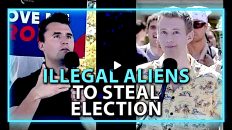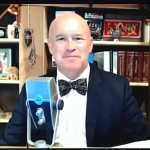TheBigPictureRT
July 30, 2012
Thom talks with NSA Whistleblowers Thomas Drake and Kirk Wiebe in tonight’s “Conversations with Great Minds.” Tonight’s “Big Picture Rumble” panel discusses the latest from spoiled rich kid Romney’s trip abroad, Obama’s call to strengthen our country’s gun control laws and why cities are banning Chick-Fil-A restaurants. In tonight’s “Daily Take” Thom discusses how voter fraud rarely happens, but when it does it’s Republicans who are usually guilty.
===
Published by ConspiracyDebates
September 17, 2012
Thomas Drake former senior executive of the NSA, was charged with ten counts of mishandling documents when he blew the whistle and questioned the Trailblazer Project. He speaks with George Knapp to discuss his career both before and after 9/11.
From Wikipedia:
Thomas Andrews Drake (born 1957) is a former senior executive of the U.S. National Security Agency (NSA) and a decorated United States Air Force and United States Navy veteran. He has experience with computer software , linguistics, management, and leadership. He is also a whistleblower. In 2010 the government alleged that he ‘mishandled’ documents, one of the few such Espionage Act cases in U.S. history. His defenders claim that he was instead being persecuted for challenging the Trailblazer Project. He is the 2011 recipient of the Ridenhour Prize for Truth-Telling and co-recipient of the Sam Adams Associates for Integrity in Intelligence (SAAII) award.
On June 9, 2011, all 10 original charges against him were dropped. He rejected several deals because he refused to “plea bargain with the truth”. He eventually pleaded to one misdemeanor count for exceeding authorized use of a computer; Jesselyn Radack of the Government Accountability Project, who helped represent him, called it an act of “Civil Disobedience.”
Biography
His father was a World War II veteran and his mother a secretary for Pearl S. Buck. He entered the U.S. Air Force in 1979. He became an Airborne Voice Processing Specialist, with a fluency in German, and went on ELINT (electronic intelligence) missions. There he encountered the surveillance state of East Germany and the Stasi, which informed his worldview and to which he compares developments in the United States since the September 11 attacks. He left the Air Force in 1989. He was also in the U.S. Navy, where he analyzed intelligence for the National Military Joint Intelligence Center. According to the Washington Post, he also at one time worked with the CIA. In 1989 he began work as an NSA contractor, evaluating software. He worked on projects like JACKPOT and LIBRARIAN. He became an expert in the quality-testing of software and worked on a system for measuring the quality of computer code at the NSA. He also continued his academic studies.
In 2000 Drake was employed as a software systems quality specialist and management and information technology consultant for Columbia, Maryland, based Costal Research & Technology Inc. (CRTI), a wholly owned subsidiary of Alexandria, Virginia, based Computer Systems Management, Inc. (CSMI). In late 2001 he went to work at the NSA as a full time employee at the Signals Intelligence Directorate at Fort Meade, Maryland. In 2002, he became a Technical Director for Software Engineering Implementation within the Cryptologic Systems and Professional Health Office. In 2003, Drake became a Process Portfolio Manager within NSA’s newly formed Directorate of Engineering. He held a Top Secret security clearance. During the congressional investigations into 9/11, he testified about NSA failures. In 2006 he was reassigned to the National Defense University, where he became the NSA Chair and an Assistant Professor of Behavioral Sciences within the Industrial College of the Armed Forces (ICAF). He was forced to leave the NDU in 2007 when his security clearance was suspended and resigned from the NSA the next year. He then went to work at Strayer University but was forced from that job after his indictment of April 2010. He found work at an Apple store. He then founded Knowpari Systems, a consulting firm.
In 2011, Drake was awarded the Ridenhour Prize for Truth Telling and was co-recipient of the Sam Adams Associates for Integrity in Intelligence (SAAII) award. Accepting the SAAII award he said, with references to an 1857 speech of Frederick Douglass:
“Power and those in control concede nothing…without a demand. They never have and they never will…each and every one of us must keep demanding, must keep fighting, must keep thundering, must keep plowing, must keep on keeping things struggling, must speak out and must speak up until justice is served because where there is no justice there can be no peace.”
Whistleblowing on Trailblazer, and government response
Drake action within the NSA
In the late 1990s and early 2000s, the NSA required new tools to collect intelligence from the growing flood of information pouring out of the new digital networks like the internet. Drake become involved in the internal NSA debate between two of these tools, the Trailblazer Project and the ThinThread project. He became part of the “minority” that favored ThinThread for several reasons, including its theoretical ability to protect privacy while gathering intelligence. Trailblazer, on the other hand, not only violated privacy, in violation of the Fourth Amendment, USSID 18, and other laws and regulations, it also required billions of dollars, dwarfing the cost of ThinThread. Drake eventually became “disillusioned, then indignant” regarding the problems he saw at the agency. Circa 2000 NSA head Michael Hayden chose Trailblazer over ThinThread; ThinThread was cancelled and Trailblazer ramped up, eventually employing IBM, SAIC, Boeing, CSC, and others.
Drake worked his way through the legal processes that are prescribed for government employees who believe that questionable activities are taking place in their departments. In accordance with Whistleblower protection laws such as the Intelligence Community Whistleblower Protection Act, Drake complained internally to the designated authorities: to his bosses, the NSA Inspector General, the Defense Department Inspector General, and both the House and Senate Congressional intelligence committees.
He also kept in contact with Diane S. Roark, a staffer for the Republicans on the House Intelligence Committee of the U.S. Congress (the House committee responsible for oversight of the executive branch’s intelligence activities). Roark was the “staff expert” on the NSA’s budget; they had met in 2000.
In September 2002, Roark and three ex-NSA members, Binney, Wiebe, and Loomis, filed a DoD Inspector General report regarding problems at NSA, including Trailblazer. Drake was a major source for the report, and gave information to DoD during its investigation of the matter. Roark also went to her boss at the House committee, Porter Goss. She also attempted to contact William Rehnquist, a Supreme Court justice. She got no response from either.
NSA own inquiry and acknowledgement
By 2003, the NSA IG had declared Trailblazer an expensive failure. It cost more than 1 billion dollars.
In 2004, the DoD IG produced a final report of its investigation that had been prompted by Roark & the others in 2002. The report basically agreed with their assertions and found very serious flaws at NSA. For a time, the NSA was even banned from starting projects over a certain size, for fear it would waste the money. However, there were no plans to release this DoD IG report to the public at the time.
Eventual whistleblowing
Jane Mayer, in her New Yorker article of 2011, writes that Drake felt the NSA was committing serious crimes against the American people; on a level worse than what president Nixon had done in the 1970s. He reviewed the laws regarding disclosure of information, and decided that if he revealed unclassified information to a reporter, then the worst thing that would happen to him was probably that he would be fired.
In November, 2005, Drake contacted Siobhan Gorman, of The Baltimore Sun newspaper. Drake began communicating with Gorman, sending her emails through hushmail and discussing various topics. He claims that he was very careful not to give her sensitive or classified information; it was one of the basic ground rules he set out at the beginning of their communication. This communication occurred circa 2006. Gorman wrote several articles about waste, fraud, and abuse at the NSA, including articles on Trailblazer. She received an award from the Society of Professional Journalists for her series exposing government wrongdoing. Judge Richard Bennett later ruled that “there is no evidence that Reporter A relied upon any allegedly classified information found in Mr. Drake’s house in her articles”.
2007 FBI raids
In July 2007, armed FBI agents raided the homes of Roark, Binney, and Wiebe, the same people who had filed the complaint with the DoD Inspector General in 2002. Binney claims they pointed guns at his wife and himself. Wiebe said it reminded him of the Soviet Union. None of these people were charged with any crimes. In November 2007, there was a raid on Drake’s residence. His computers, documents, and books were confiscated. He was never charged with giving any sensitive information to anyone; the charge actually brought against him is for ‘retaining’ information [18 U.S.C. § 793(e)]. The FBI tried to get Roark to testify against Drake; she refused. Reporter Gorman was not contacted by the FBI.
Drake initially cooperated with the investigation, telling the FBI about the alleged illegality of the NSA’s activities.[29] The government created a ‘draft indictment’ of Drake, prepared by prosecutor Steven Tyrrell. It listed charges as “disclosing classified information to a newspaper reporter and for conspiracy”. Diane Roark, Binney, Wiebe, and Loomis (the complainants to the DoD IG in 2002) were also allegedly listed as “unindicted co-conspirators”. In 2009 a new prosecutor came on the case, William Welch II, and changed the indictment. Some charges were removed, as was any naming of ‘co-conspirators’. The new case only contained charges against Drake.
Prosecutors wanted Drake to plead guilty, but he refused. He believed that he was innocent of the charges against him. The government wanted him to help prosecute the other whistleblowers. He refused this as well. He later explained his motivations to the Ridenhour Prizes organization:
“I did what I did because I am rooted in the faith that my duty was to the American people…”I knew that you did not spy on Americans and that we were accountable for spending American taxpayer monies wisely.”
Indictment
In April 2010, Drake was indicted by a Baltimore, Maryland, grand jury on the following charges:
– Willful Retention of National Defense Information 18 U.S.C. § 793(e): 5 counts
[793(e) is a modification of the Espionage Act of 1917 made under the McCarran Internal Security Act of 1950]
– Obstructing justice 18 U.S.C. § 1519 (1 count)
– Making a False Statement 18 U.S.C. § 1001(a) (4 counts)
The indictment contains many other allegations; most of them do not relate to the actual charges against him. He was not specifically charged with unauthorized disclosure of classified information, nor was he charged at all under 18 U.S.C. § 798, the “SIGINT” statute. The indictment gives details about his communications with Roark and with Gorman, but he is not charged with any crime directly relating to those communications. The indictment also did not list the names of Gorman or Roark, but they were confirmed by reporters (i.e. Hosenball of Newsweek). Roark’s lawyer has claimed the indictment contains a “mischaracterization of the facts” about the relationship between her client and Drake. Roark herself later spoke out in support of Drake and the other whistleblowers of the Trailblazer project.
The ‘Willfull retention’ charges are regarding five documents allegedly ‘related to the national defense’ that were found at Drake’s residence. The five documents in question are referred to as “What a Success”, “the Regular Meetings”, “Volume is our Friend”, “Trial and Testing”, and “Collections Sites”. “What a Success” was declassified a few months after Drake was indicted. “Regular Meetings” was marked “UNCLASSIFIED” and posted on NSANet but prosecution argues the defendant should have known it was really classified. Drake’s team also argued that the latter 3 of the 5 documents were part of a collection of thousands of unclassified papers related to the DoD Inspector General Report (mentioned above). Defense argues this means the defendant brought home the material accidentally, not ‘willfully’.
The obstruction charge is related to allegedly deleting documents while knowing the FBI was investigating leaks to the media, and that it was contemplating investigating leaks to the aforementioned reporter. The false statements charge come out of the FBI’s questioning of Drake without a lawyer present, in the initial stages of the investigation when he was cooperating with them. One count is for alleged statements made by him regarding whether he had willfully taken certain documents home. Another count is for allegedly lying about allegedly giving classified information to Gorman. Drake’s defenders point out that the government’s own expert has found that he did not destroy any evidence. They also point out that he was careful not to give any classified information to Gorman, and that many of the documents in question were ‘retroactively classified’ after they were seized from his home by the FBI.
Offices involved in the indictment included the DOJ Public Integrity Section, DOJ Criminal Division, DOJ National Security Division, the FBI, and the NSA Office of Security & Counterintelligence. Drake is being represented by James Wyda and Deborah Boardman, federal public defenders.
Drake is a client of the Government Accountability Project, a whistleblower non-profit. Jesselyn Radack, director of Homeland Security and Human Rights for GAP, worked with Drake. Author James Bamford was a consultant for Drake’s defense as well.
Government prosecutor William M. Welch II (previously charged with contempt and removed from the Ted Stevens case) is the government’s Senior Litigation Counsel on the case. John P Pearson of the DOJ Public Integrity Section is the government’s Trial Attorney. Lanny A. Breuer is overseeing the prosecution.
Judge Richard D. Bennett is handling the case. Trial is scheduled for June 2011.
The Drake case has been written about in the Washington Post, the New York Times, Agence France-Press, Newsweek.com, Wired, the Washingtonian.com, the Federation of American Scientists’ Secrecy News, Politico, and elsewhere. Jesselyn Radack, of the Government Accountability Project, has also discussed the case.
Court proceedings
In the spring of 2011, the prosecution made several moves to restrict the normally open proceedings of a jury trial in a United States courtroom, as reported by Gerstein at Politico and others. This is done per the Classified Information Procedures Act, which attempts in theory to prevent the release of classified information during open trials. The prosecution also moved to use the controversial ‘silent witness rule’, in which exhibits are hidden from the public by the use of ‘code words’ in court. The government has only attempted to use the rule a handful of times; its legality has been challenged under the Fifth and Sixth Amendments. The government also moved to restrict cross-examination of witnesses, to restrict jurors from reading the Siobhan Gorman Baltimore Sun articles about problems with NSA and Trailblazer, and to prevent the defense from making arguments or introducing evidence to the courtroom about whistleblowing or overclassification.
The prosecution also attempted (successfully) to seal two exhibits the defense had published in one of their public court filings, which listed various documents the prosecution would try to use at trial.
The prosecution has also argued that the CIPA applies to non-classified information and has attempted to redact unclassified information at trial.
Government arguments
The government claimed the “newspaper articles are unduly prejudicial. The only purpose for the admission of these newspaper articles is to put NSA on trial.” It also believed that it “does not have to prove that defendant intended to harm the country” under the specific part of the Espionage Act that Drake is charged with; 18 U.S.C. § 793(e). As for the ‘overclassification’ defense, the government has argued that it is ‘confusing to the jury’ and irrelevant to the charges. The government argues the whistle-blower defense is irrelevant to the charges as well.
Final Disposition
In early June, shortly after the May 22, 2011 6:00 pm broadcast of a 60 Minutes episode on the Drake case, the government dropped all of the charges against Drake and agreed not to seek any jail time in return for Drake’s agreement to plead guilty to a misdemeanor of misusing the agency’s computer system. Drake was sentenced to one year of probation and community service.
At the July sentencing hearing the judge, Richard D. Bennett of the Federal District Court, issued some harsh words for the government, saying that it was “unconscionable” to charge a defendant with a list of serious crimes that could have resulted in 35 years in prison only to drop all of the major charges on the eve of trial. The judge also rejected the government’s request for a large fine noting that Drake had been financially devastated, losing his $154,600 job at the NSA and his pension.
Afterwards
Drake appeared on The Daily Show on August 6, 2012 to talk about the history of his case, and in September sent an audio message of support to CryptoParty.
The Espionage Act and whistleblowing
Drake is one of four individuals in the history of the United States who has been charged specifically with “willful retention” of “national defense” information under 18 U.S.C. § 793(e). Most prosecutions are for “delivery” of classified information to a third party – something that Mr Drake was not charged with. This particular portion of the Espionage Act was created in 1950 during the Second Red Scare, as part of the McCarran Internal Security Act. Anthony Russo and Daniel Ellsberg were the first to be prosecuted for the “retention” of what came to be known as the Pentagon Papers which Ellsberg gave to The New York Times, eventually resulting in another landmark Espionage Act case in 1971, New York Times Co. v. United States. The prosecution of Russo and Ellsberg was dismissed in 1972 because of government misconduct. The second prosecution was of Samuel Loring Morison in 1985, a Navy analyst who sold satellite photographs to Jane’s Defense Weekly; he was later pardoned by President Bill Clinton. The third was the American Israel Public Affairs Committee case in 2005 (United States v. Franklin, Rosen, and Weissman).











Add comment